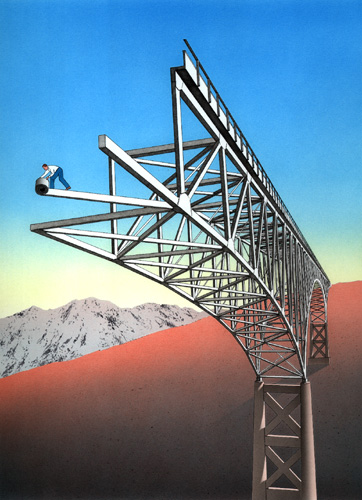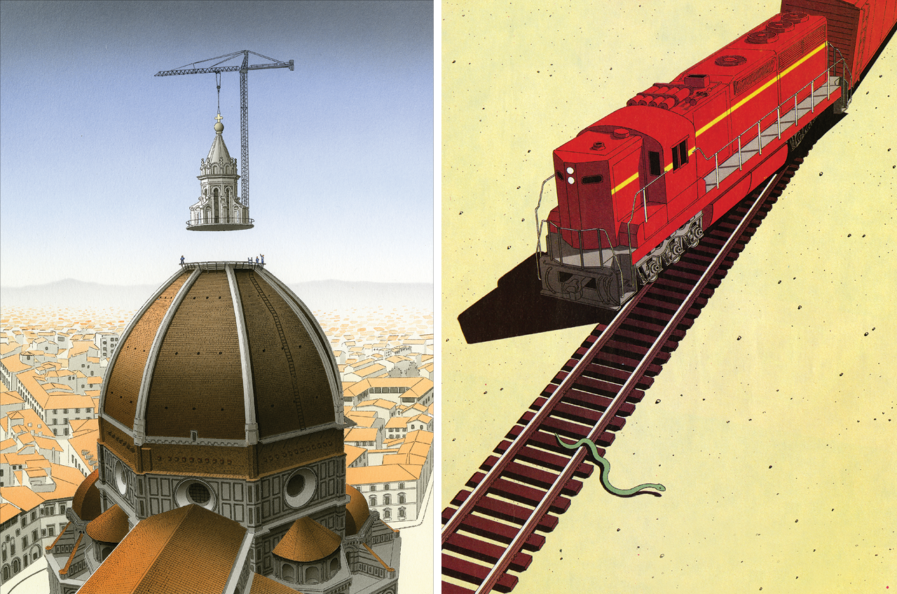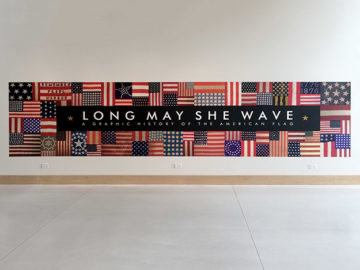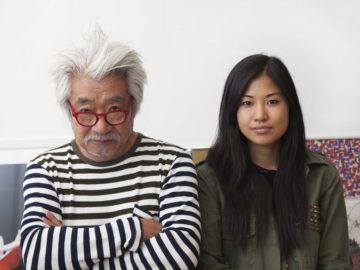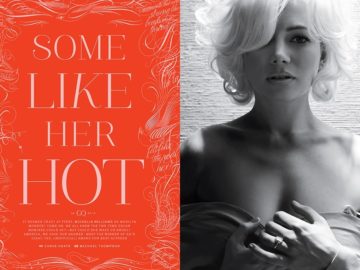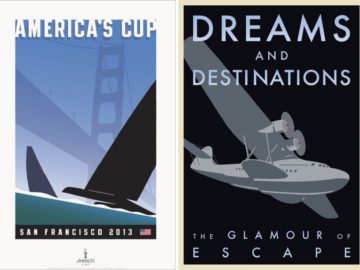In the latest issue of the Graphis Journal, readers are treated to an exclusive conversation with the legendary illustrator Guy Billout. New York City-based Guy, a French surrealist, creates mind-twisting artworks that feature realistic settings with one factor that turns everything around. His work, characterized by its meticulous detail and clever visual commentary, has graced the pages of prestigious publications worldwide. In this Q&A, Guy opens up about procrastination, his creative process, and inspirations.
Introduction by Timothy Cain, Artist & Illustrator
How do you introduce an icon who needs no introduction? A man who can tell a complete story without words? In a world of visual overload, Guy Billout pushes “pause” with a child’s pen and a higher power’s intellect. Few artists possess his innate competence to unfold mysteries in one simple “Aha!” moment. Guy’s x-ray brilliance peers around the corner and beneath the surface into what’s hidden in plain sight. And we want more. Part seer, part seeker, and part sage, his nuance is his genius, his wonder our delight. Like Escher with wings, the concept is complete, clever, and unimaginably its own. Often imitated, never reproduced, there could be a Guy Billout Award for the quickest “draws” in conceptual creativity. Enter in…
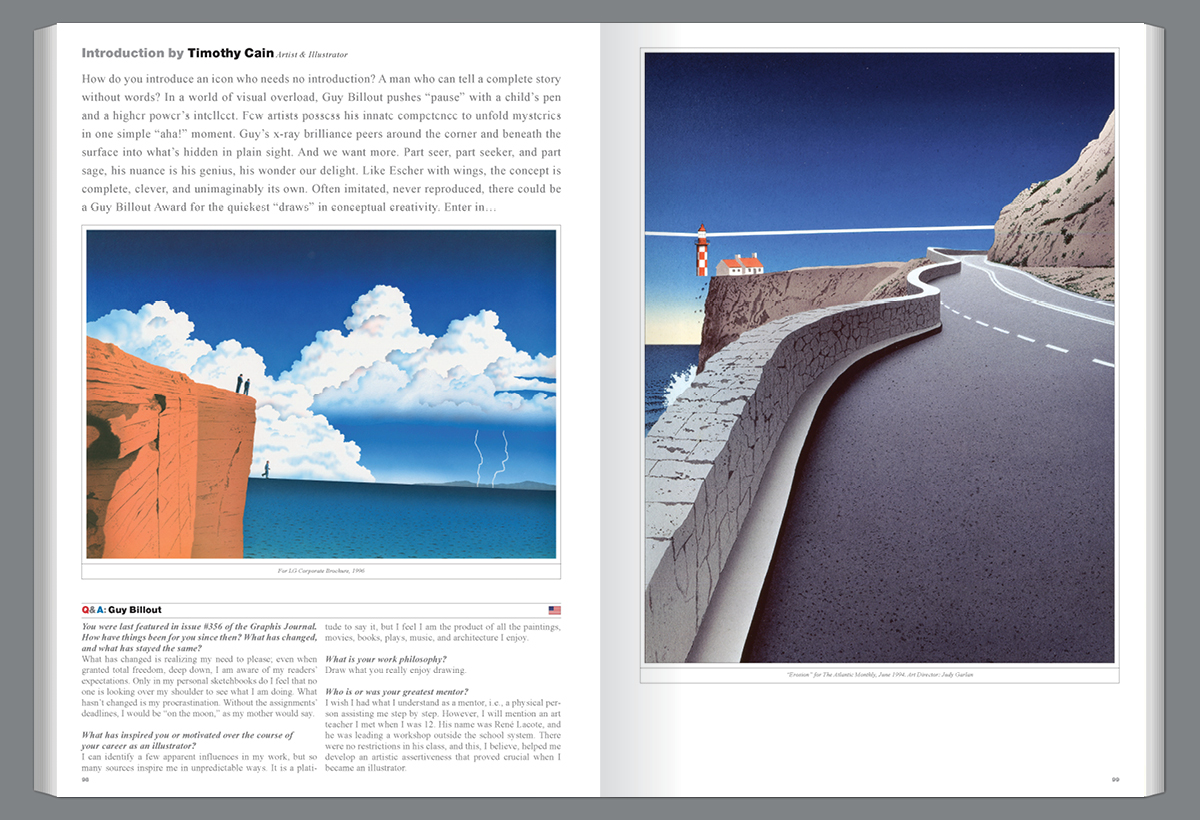
You were last featured in issue #356 of the Graphis Journal. How have things been for you since then? What has changed, and what has stayed the same?
What has changed is realizing my need to please; even when granted total freedom, deep down, I am aware of my readers’ expectations. Only in my personal sketchbooks do I feel that no one is looking over my shoulder to see what I am doing. What hasn’t changed is my procrastination. Without the assignments’ deadlines, I would be “on the moon,” as my mother would say.
What has inspired or motivated you over the course of your career as an illustrator?
I can identify a few apparent influences in my work, but so many sources inspire me in unpredictable ways. It is a platitude to say it, but I feel I am the product of all the paintings, movies, books, plays, music, and architecture I enjoy.
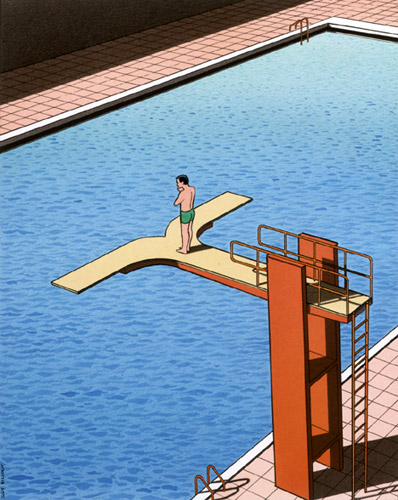
What is your work philosophy?
Draw what you really enjoy drawing.
Who is or was your greatest mentor?
I wish I had what I understand as a mentor, i.e., a physical person assisting me step by step. However, I will mention an art teacher I met when I was 12. His name was René Lacote, and he was leading a workshop outside the school system. There were no restrictions in his class, and this, I believe, helped me develop an artistic assertiveness that proved crucial when I became an illustrator.
Who among your contemporaries today do you most admire?
I have a long list of contemporaries I admire; out of this list, I single out Christoph Niemann because he embodies the principles that have inspired me since I started working as a graphic
designer in advertising: good ideas, easy to understand, and well-executed. Christoph comes up with exquisite, intelligent concepts doubled with a keen sense of humor. His graphic virtuosity and an uncanny ability to reinvent himself with various stylistic approaches make him peerless.

Who have been some of your favorite colleagues or clients?
I am grateful for the first professional persons I met shortly after arriving in New York in 1969: Bob Ciano, art director at Redbook magazine, and Kit Hinrichs, graphic designer at Russell & Hinrichs. Both trusted me with my very first assignments. It was more remarkable since I had never been published as an illustrator. We immediately related, despite my very limited English, and many years later, I remain in touch with these generous and talented friends.
At about the same time, I met Milton Glaser, who was already a hero of mine back in Paris. As the art director of the New York magazine, he published all 13 biographical drawings that composed the illustration portfolio I had improvised before coming to New York. Étienne Delessert, an outstanding children’s book author and illustrator, was instrumental in helping me navigate my new world and introducing me to Harlin Quist, the publisher of Étienne’s pioneering stories with Eugène Ionesco and of my first children’s book.
Another extraordinary encounter occurred in 1982 when Judy Garlan, the art director of The Atlantic, gave me the most unusual assignment by granting me total editorial freedom for a full-page illustration in color. That became a regular feature that lasted 24 years. I owe a great deal to her because her assignment allowed me to break new ground; free of any theme or text written by someone else, I had to rely on my most intimate resources for inspiration. This generated some images with an emotional and poetic charge that I’ve seldom attained in regular assignments, even in my children’s books.
What are the top things you need from a client to do successful work for them?
Mostly to give me carte blanche.
How did you develop your illustration style?
Style has always been the least of my concerns. As a student, I never looked for a style; I just drew.
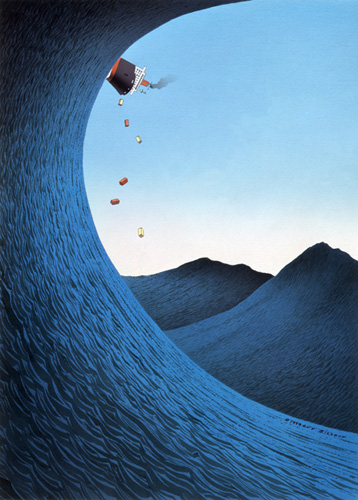
What tools do you use to make your illustrations?
At the beginning of my career, I used Dr. Ph. Martin’s dyes with a brush until I discovered the airbrush in the 70s. Most of my physical work was done with this technique. With the advent of the computer, my illustrations gradually became digital, although I always draw with a pen on paper before coloring with Photoshop.
Your illustrations have been featured in numerous publications and periodicals. Is there a publication you enjoyed working with the most? What have been your favorite work assignments?
By far, the regular feature commissioned by Judy Garlan for The Atlantic.
You have also illustrated seven children’s books. What is the process like, and which book is your favorite?
Perhaps the best answer to this question is my first and favorite children’s book, Number 24, by Harlin Quist. I was still a beginner when Harlin approached me with the proposal: “Do a book—whatever you like.” To my surprise, I had none of the anxiety that usually visited me, even with the most modest assignment. I retired to a motel room for two months and created the story of a boy imagining all sorts of catastrophes happening to all kinds of vehicles while waiting for the school bus. When the bus arrives, nothing happens, and the boy has to go to school. The wordless story poured out of me with remarkable ease. It was the first hint of my aptitude as an author.
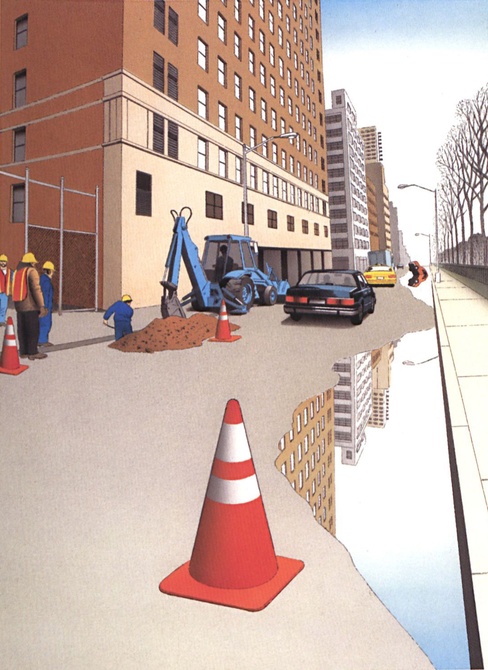
What about your work gives you the greatest satisfaction?
When I complete an image that surprises me. By contrast, I keep a box I call the “Box of Horrors” for images I bungled. In some cases, the reasons for failing are as enigmatic as succeeding.
What professional goals have you reached, and what goals do you still have for yourself?
I am not sure I ever had precise professional goals. If the way I became an illustrator is a good example, I seem to rely on improvisation and adapting to circumstances. Today, I have lost the drive to work on stories written by others and, to some extent, to write my own stories for children’s books, but I would love to write and illustrate a graphic novel. Teaching also still gives me a sense of purpose.
What would you change if you had to do it all over again?
Nothing. I still marvel at how things turned out since I arrived in New York.
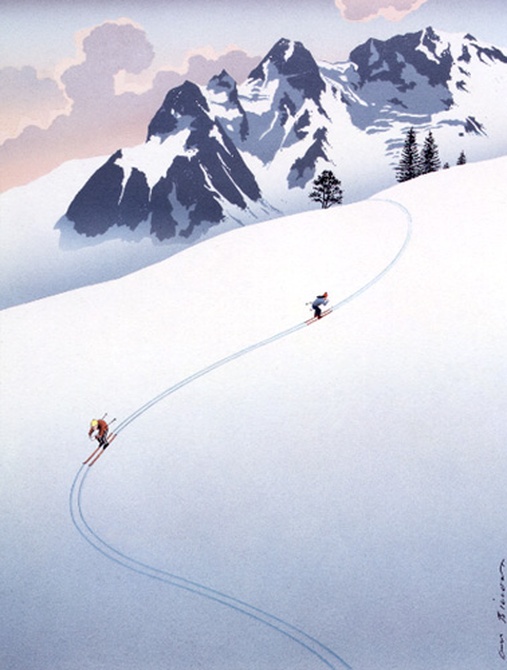
Who are the rising stars of illustration?
There was a time when I closely watched the work of the best illustrators. I devoured Graphis long before I became an illustrator. I am now more interested in other fields, like comic strips and the great painters.
How do you balance your work with your personal life if there is a distinction between the two for you?
The American language has a good word that applies to me: workaholic. There is an exception to my devotion to assignments; over the years, I have created birthday cards, Valentine cards, etc. for my wife, Linda. This allows me to indulge in a genre I really love but seldom practice: cartoons.
In what ways do you see your field changing over the years?
It may be irrelevant today to evoke the way it was when I arrived in this country. In 1969, every art director I called made a point to meet me in person, without exception. I also saw the slow erosion of the power of art directors to the benefit of people of the text, like editors, not to mention the shrinking of budgets. But illustration continues. I remain amazed by the quality of what I see in professional publications, though not in magazines.
